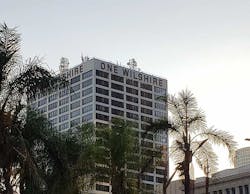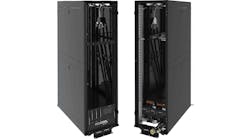LOS ANGELES – An ambitious upgrade of power and cooling infrastructure at One Wilshire has boosted the iconic carrier hotel’s capacity to deploy new data center space.
The upgrades were undertaken by building owner GI Partners, which worked with engineering firm Swanson Rink and cooling specialist Data Aire to expand the building’s riser space, cooling capacity and electrical infrastructure, including a four-story platform to house additional backup generators.
The two-year project allowed One Wilshire to expand its power capacity to 20 MVA, while enabling new data center space to be deployed for CoreSite at a highly efficient PUE (Power Usage Effectiveness) of 1.2, with a cooling system that can provide full-economization for 72 percent of the time – 260 days a year.
The team behind the project recently presented a case study at the 7×24 Exchange Fall Conference in Phoenix, reviewing the challenges in such a major upgrade of an older building in an urban center.
A Los Angeles Communications Hub
The One Wilshire building is a key hub for data traffic from Asia, with as much as a third of all trans-Pacific traffic passing through the building, according to estimates. It also serves as a key data storage and interconnection center for Los Angeles businesses, including the media and entertainment industry.
One Wilshire was built in 1967 and served office tenants for many years before beginning a shift to telecom and data center tenants in the early 1990s. The 30-story, 662,000 square foot building has a prime location next to a SBC/PacificBell central switching facility, and benefits from a rooftop with clear lines of sight that are ideal for microwave towers.
Significantly, it stands at the intersection of fiber routes that run down Wilshire Boulevard and Sixth Street, and is tied into major trans-Pacific undersea fiber cables that land about 20 miles away.
The upgrades create significant new capacity for data center space within One Wilshire, which houses more than 300 networks. Even with that critical mass of network operators, about a quarter of the space at One Wilshire remains occupied by office tenants.
The renovation was novel because it involved a major upgrade to a 50-year old building in the center of one of America’s largest and busiest cities without disrupting live services in one of the world’s most mission-critical buildings. This video from Data Aire outlines the project and how it addressed the challenges.
The first step was to create more room for equipment in a crowded downtown skyscraper.
“The building has challenges when it comes to putting in the infrastructure for data centers,” said Michael Mann of GI Partners. “It really has been a process of squeezing (infrastructure) into every corner we could find – including removing elevators to run infrastructure up an elevator shaft.”
GI Partners hired engineering firm Swanson Rink to oversee the project.
“The primary challenge was to develop effective solutions with the limitation of utility space, as all readily available floor and vertical shaft space was taken by densely packed fiber and copper communications cables,” said Gary Orazio, the President of Swanson Rink. “Without a building-wide solution for cooling and power, each tenant developed its own solution, which used all remaining space for power and unitary cooling risers. The team developed a master plan and subsequent building upgrades that allow new tenants to take advantage of fiber connectivity as well as Tier III mechanical and electrical infrastructure.”
Michael Mann of GI Partners discusses the One Wilshire project at the 7×24 Exchange Fall Conference in Phoenix. (Photo: Convention Photography for 7×24 Exchange)
A key step was repurposing one of the building’s elevator shafts as a utility riser to house conduit, piping and cabling for the expanded fiber and cooling infrastructure. The team also created space for a new equipment room on the 4th floor, and replaced coils in air handling units on the 30th floor to increase capacity for general building loads.
The Swanson Rink team worked with Los Angeles Department of Water and Power (LADWP), the utility provider for One Wilshire, to expand the power service. New switchgear was installed to support four incoming 34.5 kV feeders that provide up to 47.5 MVA of capacity to the site in an N+1 configuration.
The expansion created the need for additional capacity for emergency standby power. A four-story mezzanine was built in a parking lot next to the building, making space for two 3.1 megawatt generators and supporting paralleling switchgear. A 5kV power riser was added that runs from the 4th floor to 30th floor, with 480V distribution on 16th and 30th floor.
The power upgrades set the table for one of the most challenging and important elements of the project – a new cooling system that could dramatically expand One Wilshire’s ability to use free cooling (economization) to cool its data center space. Data Aire joined the project to create a solution that could meet the goals of using free cooling for 50 percent of the year.
“Every environment is unique, whether it’s the build or the location or the weather,” said Eric Jensen, Vice President and General Manager at Data Aire. “There are instances where a site-optimized solution is required. At the time, we didn’t have a system that did everything they wanted. However, through an iterative process over the course of over a year, we developed something that actually exceeded the original requirements.”
The One Wilshire panel at the 7×24 Exchange Fall Conference. From left: Gary Orazio of Swanson Rink, GI Partners’ Michael Mann, Eric Jensen from Data Aire, and moderator Rich Miller of Data Center Frontier. (Photo: Convention Photography for 7×24 Exchange)
The Data Aire solution featured a central condenser water system, which supplied 67-degree water, and a CRAC System based on gForce Ultra technology to provide 72-degree air.
The gForce system that has two cooling coils in series. One is a refrigerant coil using the compressors to make cooling, along with a chilled water coil that uses water from the cooling tower for cooling — referred to as the Energy Saver coil. The chilled water coils and the condensers are oversized to provide maximum economization hours. Most importantly, the system includes a variable speed compressor operated by a VFD, which saves energy.
Economization Exceeds Expectations
The resulting system can provide full-economization about 72% of the year, exceeding the project goal of 50 percent. The system can run 260 days a year with full economization and 105 days a year with partial economization, with a PUE of 1.2 at full load.
A key beneficiary was CoreSite, which is the largest data center company at One Wilshire and operates the building’s Meet-Me Room. CoreSite was able to use the cooling system in an expansion of its colocation space.
“We required more cooling and more efficiency out of a smaller footprint,” said Kenyatta Drones, Director of Facilities and Operations at CoreSite Los Angeles. “That required some ingenuity and some engineering. The Data Aire team came up with a solution, and they went and modified their product to meet our needs here. It’s a fantastic solution, because it gives you more efficiency, and at CoreSite we’re always looking for anything that can make you more efficient, especially in a former carrier hotel.”








